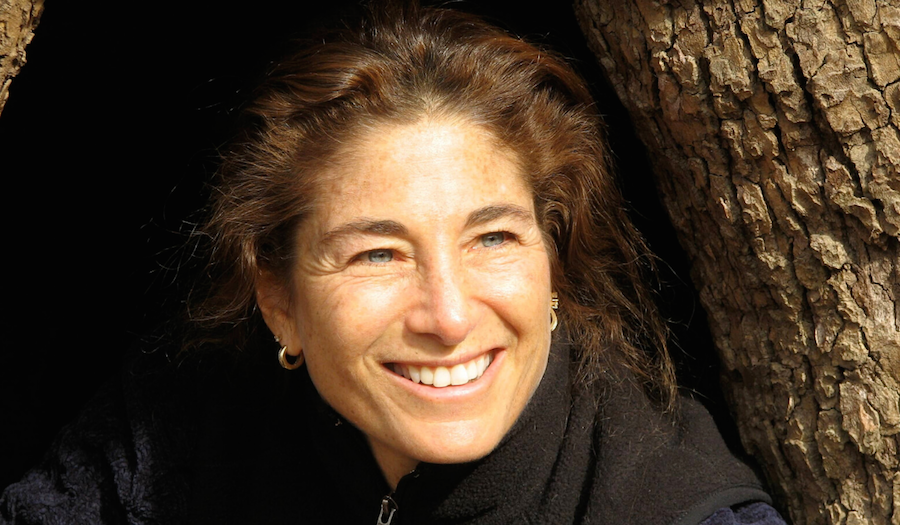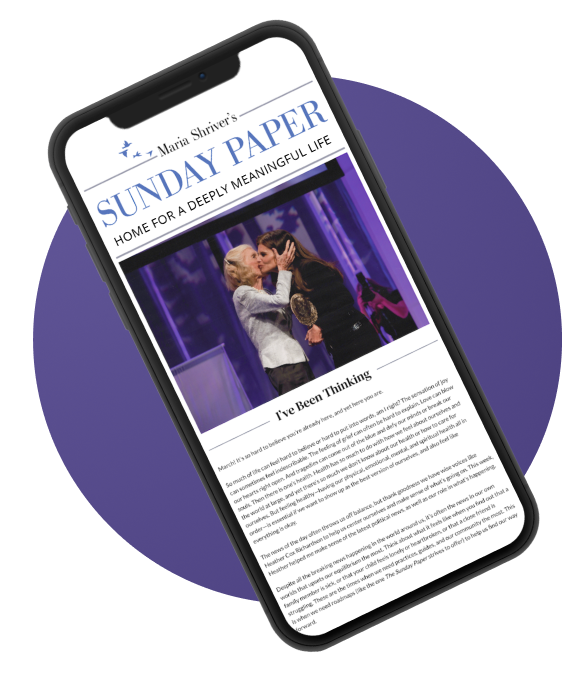Tara Brach’s Non-Radical Approach to ‘Radical Compassion’

Photo credit: Jonathan Foust
Tara Brach, Ph.D., is a clinical psychologist and bestselling author, internationally renowned as a teacher of mindfulness meditation. In her latest book, “Radical Compassion: Learning to Love Yourself and Your World with the Practice of RAIN,” she offers an antidote to stress and anxiety in an easy-to-learn, four-step meditation that quickly loosens the grip of difficult emotions and limiting beliefs.
We spoke with Brach about her RAIN meditation and why it works.
And be sure to sign up for Brach’s Radical Compassion Challenge. It’s this week’s Sunday Paper Exclusive Offer, and it features our own Maria Shriver!
1. Why is this book so important for this day and age?
If you fly cross-country, it’s more than likely that the person sitting next to you either meditates or has a close friend who practices. Mindfulness courses are in our schools, businesses, hospitals and the halls of Congress. We humans are at an amazing juncture in our evolutionary journey—never in our history have so many people been intentionally cultivating states of mindfulness, clarity, balance, and kindness.
Meanwhile, we’re fast destroying our larger body, the earth, and live in a society filled with contempt, mistrust, and hostility. Sadly, even those trying to be more mindful, find themselves caught in creating others into the bad guys, the enemy. And on an individual level, we are often at war against ourselves, fueling feelings of deficiency and unworthiness.
The medicine we most need, personally and collectively, is compassion. We need to see the fear and vulnerability in ourselves and others and respond with care. In the deepest way, we need to refuse to push anyone, including ourselves, out of our hearts. Only then will we recognize and act from the truth of our mutual belonging.
Radical Compassion introduces the RAIN meditation as a powerful spiritual technology for cultivating compassion in the face of difficult emotions. Through the acronym RAIN (Recognize-Allow-Investigate-Nurture) we can awaken the qualities of mature compassion—an embodied, mindful presence, active caring, and an all-inclusive heart. I’ve now taught this mode of practicing RAIN to hundreds of thousands of people, and am regularly told, “This has changed my life.”
2. Can you explain the RAIN meditation?
The four steps of RAIN are easy to learn and can be brought to any experience of emotional difficulty.
R—Recognize What’s Going On
Recognizing means consciously acknowledging, in any given moment, the thoughts, feelings, and behaviors that are affecting us. You might notice a critical inner voice, feelings of shame or fear, the squeeze of anxiety or the weight of depression in the body. Recognizing can be a simple mental whisper, noting what has come up.
A—Allow the Experience to be There, Just as It Is
Allowing means letting the thoughts, emotions, feelings, or sensations we have recognized simply be there, without trying to fix or avoid anything. When we’re caught in self-judgment, letting it be there doesn’t mean we agree with our conviction that we’re unworthy. Rather, we honestly acknowledge the arising of our judgment, as well as the painful feelings underneath.
I—Investigate with Interest and Care
Once we have recognized and allowed what is arising, we can deepen our attention through investigation. To investigate, call on your natural curiosity—the desire to know truth—and direct a more focused attention to your present experience. You might ask yourself, What most wants attention? How am I experiencing this in my body? What am I believing? What does this vulnerable place want from me? What does it most need? Whatever the inquiry, your investigation will be most transformational if you step away from conceptualizing and bring your primary attention to the felt-sense in the body.
N—Nurture with Self-Compassion
Self-compassion begins to naturally arise in the moments that we recognize we are suffering. It comes into fullness as we intentionally nurture our inner life with self-care. To do this, try to sense what the wounded, frightened or hurting place inside you most needs, and then offer some gesture of active care that might address this need. Does it need a message of reassurance? Of forgiveness? Of companionship? Of love? Experiment and see which intentional gesture of kindness most helps to comfort, soften or open your heart. You might find the message of kindness deepens if you lightly place your hand on your heart.
If it feels difficult to offer yourself love, bring to mind a loving being—spiritual figure, family member, friend or pet—and imagine that being’s love and wisdom flowing into you. Nurturing can come from any imagined source.
“After the RAIN”
When you’ve completed the active steps of RAIN, it’s important to just notice your own presence and rest in that wakeful, tender space of awareness. The fruit of RAIN is realizing that you are no longer imprisoned in any limiting sense of self. Give yourself the gift of becoming familiar with the truth and natural freedom of your being; it is mysterious and precious!
3. Can you share a story from your book that shows us how the practice and teachings of RAIN works?
In a far-off land, word spread far and wide of a holy man with magic so powerful it could relieve the most severe suffering. After seekers of healing traveled through the wilderness to reach him, he’d swear them to secrecy about what was next to pass between them. Once they took the vow, the holy man asked a single question: “What are you unwilling to feel?”
Learning to directly face anxiety and fear with the RAIN meditation gives you a pathway to inner transformation and a fearless heart.
After a daylong seminar on RAIN and stress, “Brianna” came up to me and asked for some help with a personal situation. She’d recently been hired as a marketing vice-president in a large corporation, but she felt intimidated by the CEO, who was very quick to cut off anyone who was “wasting his time.” He ruled over the weekly staff meetings, which Brianna described as “torture” that put her into a state of “brain freeze.”
“I shouldn’t be worried about my competence,” she said. “I was recruited because I got an industry award at my last job. But the atmosphere here is totally different—really corporate, and the other VPs pretty much ignore me. I just go back to my office with my stomach churning and wonder how long I’ll last.
I suggested that Brianna practice RAIN for a few minutes right before each meeting and asked her what was going on for her at that time. “On those mornings I can really feel the anxiety building, and it lands me in a frenzy of busyness…reviewing reports, marking what I might need to comment on…nothing really productive.”
I smiled because I recognized that feeling all too well. “Okay, so before you start RAIN, imagine you’re pressing the pause button on that frenzy.”
Brianna closed her eyes and pictured herself at her desk, a half-hour before the weekly meeting. “As you pause,” I said, “your first job is to Recognize the anxiety and Allow it to be there.” After she nodded, I added, “Now, what do you notice if you bring your attention and interest to how it feels in your body?”
Beginning to Investigate, she muttered, “Dry mouth . . . really tight chest. . . heart hammering. . . and, oh yeah, my stomach’s in knots.” I suggested she place her hand on her abdomen and send her breath there with a long slow inflow and outflow. This would to help her steady her attention and stay in contact with the fear.
Now I guided her to ask the scared place inside her what it needed most, a key inquiry in Investigating. After a moment, she looked up, surprised. “It said, ‘Let it be ok that I’m here.’”
So the Nurturing that scared place needed was to be accepted, not to be made “wrong.” I asked Brianna how the wisest, kindest part of her wanted to respond. Could she find a way to acknowledge this very vulnerable part of herself with compassion?
She sat quietly, still breathing slowly, her hand on her belly. Then she nodded. “I just sent the message ‘It’s ok…this belongs.’ And…it does feel more ok. I’m actually a bit more relaxed.”
This became Brianna’s RAIN practice each week before going to the staff meeting. And when she felt anxiety spiking during the meeting, she’d simply breathe into it and send the message, “It’s ok…this belongs.”
About three months later, Brianna updated me. Her tension around the CEO hadn’t disappeared, but her anxiety had lessened somewhat. More important, it didn’t feel like such a big deal. “I’m not so alarmed when I get anxious,” she told me. “I was fighting it so hard, but now it’s ok that it’s there. That really does free me up.” She also shared some real progress in making creative contributions and connecting with others.
Asking yourself, “what am I unwilling to feel,” can open you to deep spiritual healing. Fear is the feeling that something is wrong and that, rather than facing it, we need to act to protect ourselves. When, instead, we have the courage to pause and meet fear with the mindfulness and compassion of RAIN, our awareness and wisdom enlarges. If we need to respond to a threat, we’ll do so—with increased balance and presence. But often we’ll see: “It’s just anxiety, it’s ok. This belongs”—and begin to unhook from a lifetime pattern of reactivity. While fears continue to arise, we have access to a heartspace that is open and free.
4. Can anyone practice RAIN?
While anyone can practice RAIN, it becomes stronger when people have a mindfulness practice, as that helps cultivate a focused, present-centered and non-judgmental attention. Also, if someone has PTSD and feels at risk of triggering a traumatic reaction, it’s important to explore this meditation with a therapist. More generally, with very intense emotions, it’s best to precede RAIN with a period of Nurture—some mode of self-soothing and calming. This creates sufficient safety and balance to move through the steps of RAIN and experience healing.
5. What do you hope readers will get from reading your book?
This book guides us to love ourselves into healing; to bring self-compassion to the wounded parts of our own being. It also invites us to feel our belonging to all of life, and to actively express our care. There is tremendous happiness and peace in feeling ourselves as part of the healing of our world—seeking to end the bias, oppression and violence towards those human and non-human animals who are most vulnerable, and together working toward the healing of our precious planet.
For more information or to purchase “Radical Compassion,” click here.
This Q&A was featured in the January 26th edition of The Sunday Paper. The Sunday Paper inspires hearts and minds to rise above the noise. To get The Sunday Paper delivered to your inbox each Sunday morning for free, click here to subscribe.

